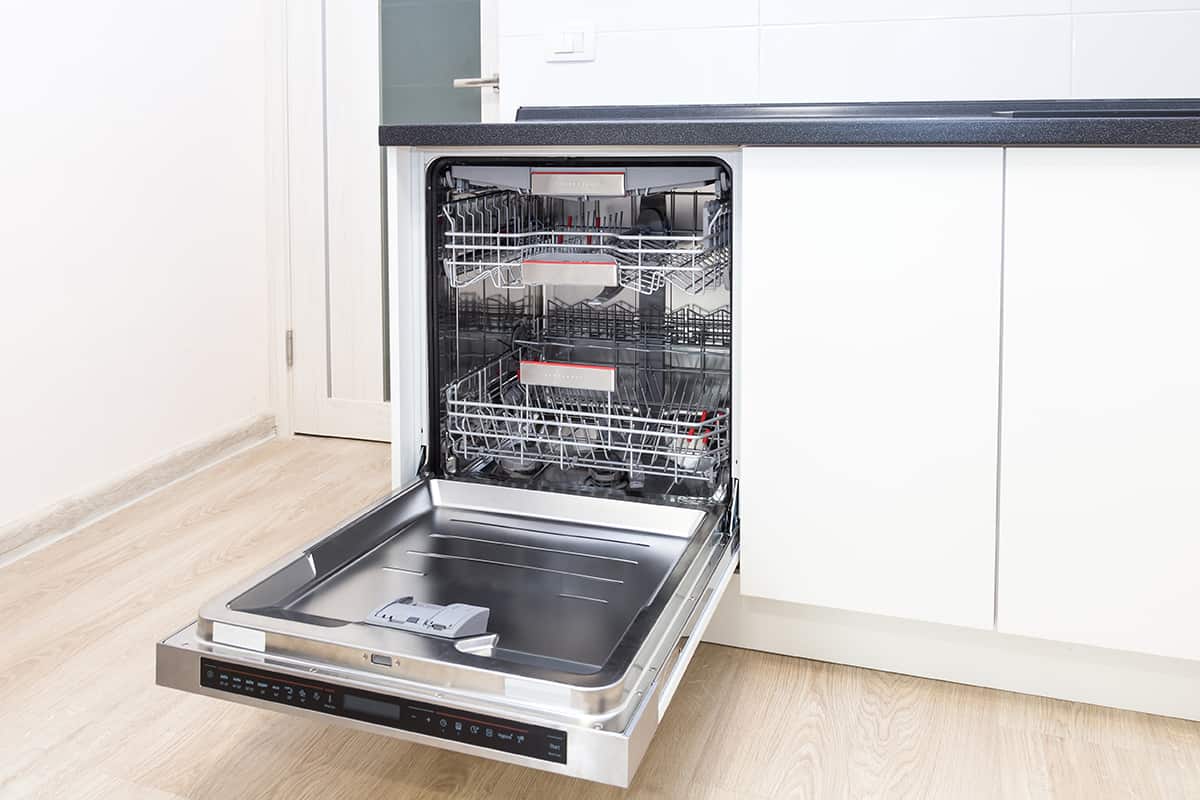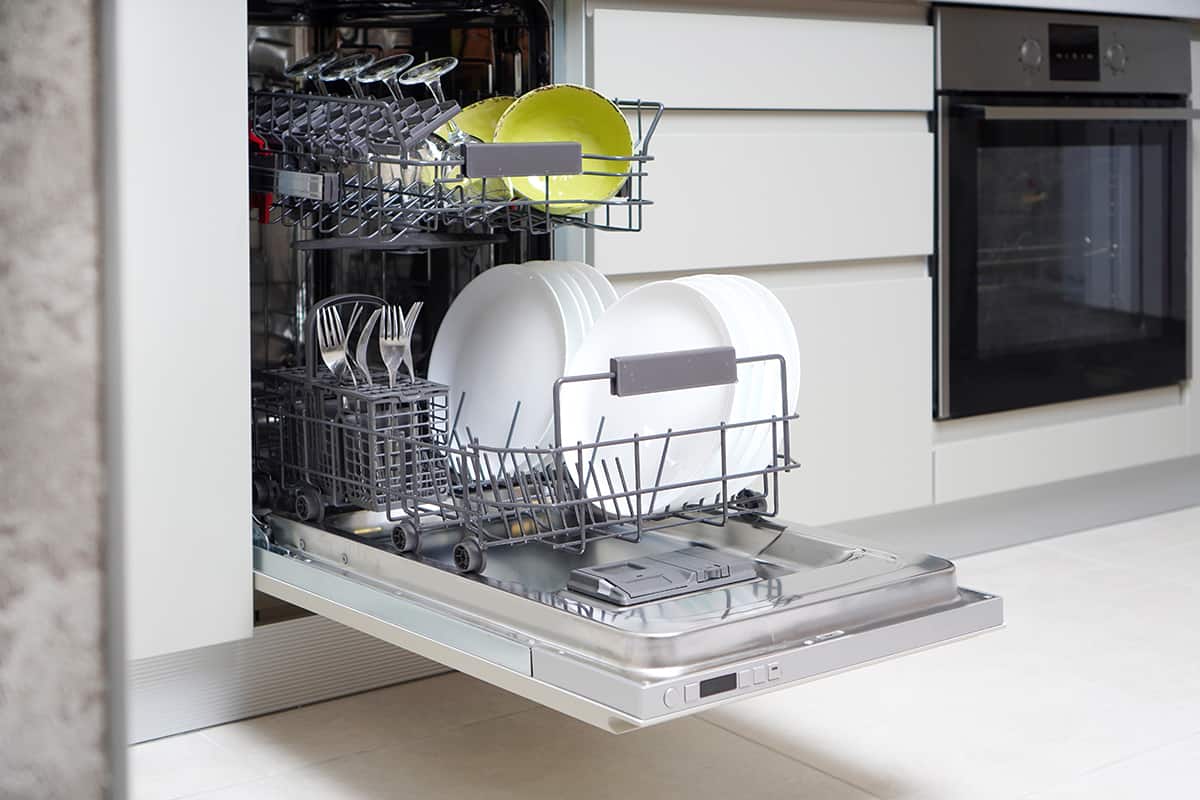We would like to think that dishwashers are invincible, but unfortunately, that’s just not true. Even a high-quality dishwasher from Bosch or KitchenAid is susceptible to damage, with the tub being one of the most commonly damaged components. So, when there’s a crack in the dishwasher tub, what should you do?
If your dishwasher’s tub has a crack in it, clean and dry the area out before applying silicone caulk or epoxy putty. Use your finger to push the caulk into the crack and smooth the surface. Let the filling agent sit until it’s fully dry and wait an additional 24 hours before running a test cycle.
In this guide, I’ll explain in greater detail how to repair a cracked dishwasher tub, whether or not this is a permanent solution, and how to tell when it’s time to replace your dishwasher.
Signs of a Cracked Dishwasher Tub
A cracked dishwasher tub is an extremely rare occurrence. So, you should be aware of the warning signs that your dishwasher’s tub is actually damaged in some way. I’ll explain the most common symptoms of a cracked dishwasher tub below.
1. Leaking
If the crack is at the bottom of the tub, it will fail to hold water. The water from the spray arms will immediately come pouring out of the machine, leaving puddles of water all over your kitchen floor. However, leaking can be a sign of all sorts of mechanical problems, so you should keep an eye out for other symptoms.
2. Long filling times
Your dishwasher fills with water at least two times per cycle. The first is to rinse your dishes and remove most of the solid debris, and the second is to mix water with the dishwasher detergent to wash and sanitize your dishes. Your dishwasher will take longer to fill with water, depending on the severity of the crack.
3. Unclean dishes
Some dishwashers follow a timer to determine how much water to add to the tub. For such machines, it can be nearly impossible to thoroughly clean the dishes since there isn’t enough water to go around. In addition, your dishes might end up with streaks since the detergent hasn’t been fully diluted in water.
Causes of a Cracked Dishwasher Tub

The tub of a dishwasher is one of the last things you’d expect to break down. After all, it’s constantly exposed to water and heat from the heating coils. While stainless-steel dishwasher tubs can handle these elements extremely well, plastic tubs don’t.
The good news is that cracked dishwasher tubs are extremely rare, so it’s not something a new dishwasher owner has to worry about. The bad news is that when it becomes cracked, pinpointing the cause can be a challenge.
With all that said, let’s take a look at the most common causes of a cracked dishwasher tub.
The heating element too close to the tub
If you’ve ever had to remove the heating element for inspection or to gain access to other internal components, then you should make sure to install it exactly how it was before you took it apart. The slightest misposition may mean that it’s too close to one corner of the wall, which can melt the plastic tub.
Dropped dishes
Before attempting to run your dishwasher, make sure you read the paperwork cover to cover. That way, you’ll have a good idea of how to use the machine. One thing many people tend to ignore is proper dish arrangement. Not only does improper loading lead to less effective washing, but the dishes may fall from their racks and crash into the tub, causing cuts or crack on the plastic surface.
The water is too hot
This is the least likely cause of a cracked dishwasher tub, but it’s something to consider. Your dishwasher uses heating coils to raise the temperature of the water to a sanitizing level. However, if your water heater is set to supply the machine with extremely hot water, it may deteriorate the plastic tub over time. When the plastic wears down, even the drop of the tiniest dish or cutlery may cause a crack in the tub.
How to Repair Crack in a Dishwasher Tub

To repair the crack in a dishwasher tub, you will need either a bottle of silicone caulk or putty epoxy sticks. Both work equally well at patching holes and cracks in dishwasher tubs, so choose whichever one is available to you.
After shutting off the dishwasher and unplugging it from its power source, here’s how you can go about repairing the crack in a dishwasher tub.
- Unload the dishwasher. Take the dishware, cutlery, and cookware out of your dishwasher. This repairing process will take over 24 hours to complete, so you might want to wash your dishes by hand for the time being. Remember to remove the dishracks and the spraying arms to gain easier access to the cracked location.
- Clean and dry the cracked spot on your dishwasher tub. The area around the crack needs to be completely rid of moisture and debris for the filling agents to work. Consider using a bit of rubbing alcohol to dry the cracked area further.
- Apply the filling agent. Use your finger and jam the filling agent inside the crack before smearing it roughly 2 inches in all directions of the crack. Smoothen the filling agent as best as you can.
- Periodically check to see when the filling agent has dried. During this time, you can gently run a finger over the caulk or putty epoxy to determine whether or not it’s dry. When it is, shut the dishwasher door and…
- Wait 24 hours before running a test cycle. The filling agent will dry completely after about 6 to 24 hours of waiting. Do not agitate the filling agent during this time. After 24 hours have elapsed, plug the dishwasher back in and run a test cycle. During the first filling phase, check your kitchen floor to see whether or not it’s leaking water.
While waiting for the filling agent to cure and run the test cycle, make sure you leave the dishwasher completely empty. That way, you can go back and add another layer of the caulk or putty to the cracked location if necessary.
Is This a Permanent Fix?
Alas, no, it’s not.
Silicone caulk and epoxy putty, while incredibly heat resistant, may not completely seal the crack forever. With constant exposure to heated water and moisture, the fillers may eventually peel away and expose the crack, bringing you back to square one.
Luckily, based on users’ experiences, caulk and epoxy putty can hold for upwards of 12 months with regular dishwasher usage. That said, you should still keep an eye out for any leaks that might accumulate on your kitchen floor.
When Should I Replace My Dishwasher?
A dishwasher usually has a lifespan of 7 to 10 years with regular use, but is a cracked dishwasher tub a legitimate reason to replace the unit entirely?
Luckily, a cracked dishwasher tub isn’t the worst thing in the world, nor is it a reason to replace your dishwasher completely. However, if you’re fed up with resealing the crack time and time again, then you might want to consider picking up a brand-new dishwasher.
Replacement tubs don’t come cheap, and they can be a huge pain in the neck to replace on your own. So, perform a cost-benefit analysis to determine whether spending money on a new dishwasher tub or a brand-new dishwasher unit is the better option.






